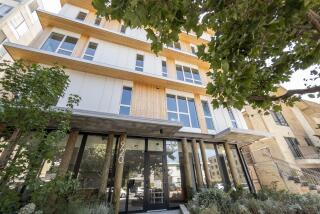Growth Issue Looms Large in Ojai Race
Mention Measure C in normally peaceful Ojai and everyone from artists to average Joes chooses up sides.
The Nov. 5 ballot initiative limiting growth and traffic has framed the debate in a highly competitive City Council race, in which six candidates vie for three seats.
Incumbents David Bury and Joe DeVito, along with challengers Paul Blatz and Bruce Roland, oppose Measure C. Challengers Leonard Klaif and Carol Smith support it. The current City Council opposes the measure as unduly restrictive.
With huge oaks, towering mountains and fragrant citrus groves so central to the town’s ambience, any threat to Ojai’s tourist allure becomes a magnet for controversy. And Measure C proves the point.
Backers say the measure would ensure new construction doesn’t overwhelm Ojai’s compact road system, which already strains to handle the crush of cars during rush hours and on weekends.
Opponents say the measure would limit growth to the detriment of all and that only wealthy developers who could afford to pay for special traffic-thinning measures would still be able to build in Ojai. Crowded out of that equation, they say, would be nonprofit organizations and small builders.
“It’s the initiative of unintended consequences,” said Tim Dewar, a Humane Society of Ventura County official and spokesman for Ojai Citizens Against Measure C.
Ojai, a tourist town of 7,800 residents -- a fifth of them senior citizens -- already has the slowest population growth rate in Ventura County, expanding by 0.3% in the past decade. Measure C could slow that even further.
The measure, written by the environmental group Citizens to Preserve the Ojai, requires the City Council to reject any new projects that would increase traffic beyond set levels. Single-family homes on existing lots would be exempt from the new rule, but so-called affordable housing projects would not be.
Developers could still build if they were able to mitigate for new traffic -- so their projects would not reduce traffic flow on nearby streets to a worse level of congestion. Traffic flow is divided into five levels, with free-flowing the best and virtual gridlock the worst.
Residents could still get popular projects built -- but only by a public vote to lower the city’s traffic standards, the initiative says.
Opponents say neither scenario is likely to occur, and no growth would be the result.
But Stan Greene, administrative director of Citizens to Preserve the Ojai, said the initiative won’t stop the kind of growth that’s good for the community. The initiative is necessary, he maintains, because the City Council isn’t doing enough to keep traffic congestion from getting worse.
The council makes too many exceptions to city traffic guidelines when it wants to pass pet projects, Greene said.
But City Manager Dan Singer said proposals are already weighed on their individual merits, and Measure C would make it “difficult, if not impossible” to continue such subjective evaluations by the council.
Speaking for the council, Mayor Steve Olsen -- who is not running for reelection -- described the initiative as “draconian,” and almost a full moratorium on growth.
Olsen said it might solve a few traffic problems on Ojai’s often-crowded streets, but at the expense of important projects such as expansions at Ojai Valley Community Hospital, the Ojai Library and badly needed affordable housing.
Dewar said Measure C would also discourage new businesses and drive up home prices.
Greene insists that the library and hospital projects would not change the level of traffic on nearby streets, so they could go forward anyway. And if significant community projects are proposed in the future that would worsen traffic flow levels, voters could then approve a different traffic standard.
“That type of discussion is like a poster boy -- everybody wants a hospital or library,” Greene said.
Olsen said traffic formulas show that if a library expands even by 1,000 square feet, more vehicles drive to it. And that could trigger Measure C’s limits.
Physician Martin Pops, vice chairman of the Ojai Valley Community Hospital Foundation, said the hospital plans to expand its tiny emergency room to four times its current size. And Measure C could undercut that effort, he said.
“The population of Ojai is growing older; more and more seniors are going to be developing chronic health-care problems,” Pops said. “We will need more nursing home care.”
The board of the nonprofit hospital cannot officially take a stand on the measure, but some officials privately said they oppose it.
Singer also said that even luxury residential projects, such as the 23-unit Los Arboles Townhomes, underway but temporarily halted next to downtown’s Libbey Park, could not be approved under Measure C. That’s because developers would likely not be able to meet traffic mitigation requirements, the city manager said.
Greene counters that any projects could be built as long as they address their traffic problems.
Even if voters approve Measure C, it might face other obstacles. City officials say that new state laws show a trend toward taking control away from cities and giving it to the state for approving low- and moderate-income housing. If a city’s laws conflict with the state, it might open itself up to a developer’s lawsuit.
William Fulton, a Ventura-based urban planning expert, also said that if Measure C is approved, a court could deem it invalid, based on state environmental laws that allow voters to make policy, but not administrative decisions.
“The argument would be that giving the voters the option to determine the levels of [traffic] would be too much of an intrusion into the administrative realm,” Fulton said.
More to Read
Sign up for Essential California
The most important California stories and recommendations in your inbox every morning.
You may occasionally receive promotional content from the Los Angeles Times.










